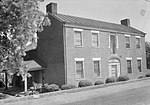Martin House (Cincinnati, Ohio)

The Martin House is a historic residence in the Mount Washington neighborhood of Cincinnati, Ohio, United States. Built in 1847, the house is composed of two pieces: the original section, located in the back; and the front, built in 1852. Between the two components, it features elements of the Greek Revival and Federal architectural styles. Built of brick, two stories tall, it was originally a farmhouse belonging to John C. Martin, who built his home on property owned by his father-in-law Ezekiel Rigdon, who owned nearly 100 acres (40 ha) of land on Mount Washington near the farm of one of the area's first settlers.In 1979, the Martin House was listed on the National Register of Historic Places, because of its status as a well-preserved example of the area's architecture. By this point, the house was owned by a religious organization and was also known as the "Heritage House;" it received national recognition because it had almost never been altered after the construction of the front component, and few other houses in the area built at a similar time retained so many of their original components.
Excerpt from the Wikipedia article Martin House (Cincinnati, Ohio) (License: CC BY-SA 3.0, Authors, Images).Martin House (Cincinnati, Ohio)
Short Park Trail,
Geographical coordinates (GPS) Address Website Nearby Places Show on map
Geographical coordinates (GPS)
| Latitude | Longitude |
|---|---|
| N 39.130555555556 ° | E -84.358611111111 ° |
Address
Little Miami Golf Center
Short Park Trail
45227
Ohio, United States
Open on Google Maps






